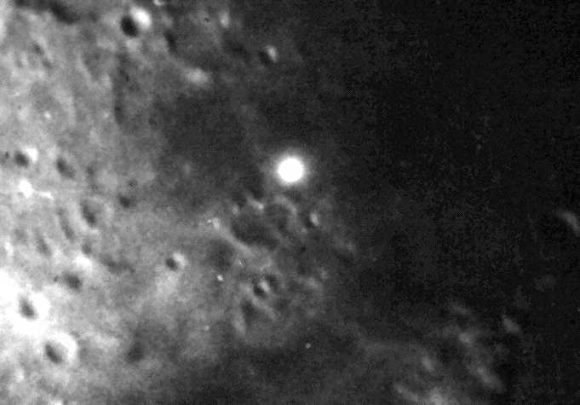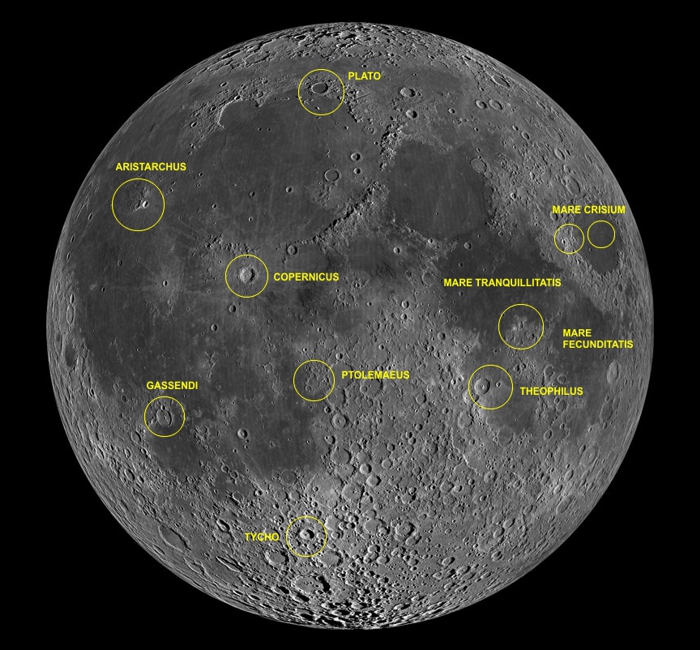
Even though it’s so close and has been visited by both robotic spacecraft and human astronauts, the moon can still be a mysterious place. There is a lot we still don’t know about our nearby neighbor, including what causes unusual flashes of light and other light phenomena on its surface. These brief light displays – also known as Transient Lunar Phenomena (TLP) – have been seen for centuries, but they’re still not entirely explained. Recently, a professor in Germany announced his new study to try to figure out, at last, what is creating these intriguing lunar phenomena.
Hakan Kayal is Professor of Space Technology at Julius-Maximilians-Universität Würzburg (JMU) in Bavaria, Germany. He wants to try to find the explanation(s) for these odd light phenomena. He and his team have built a new telescope in a private observatory in Spain. The new telescope started lunar observations in April 2019. It is in a rural area far from light pollution about 60 miles (100 km) north of Seville. As to why it is located in Spain, Kayal said:
There are simply better weather conditions for observing the moon than in Germany.
The telescope has two cameras that observe the moon, remote-controlled from the JMU campus in Germany. If a flash or other light source is detected, the cameras will trigger other actions from the telescope, but only if both cameras make the detection. Photos and video are automatically taken and recorded, and an email is sent to Kayal and his team.


The software being used at Kayal and his team’s telescope is still being refined. Eventually, it’ll incorporate artificial intelligence – estimated to take another year to complete – so that then system will gradually learn to distinguish a moon flash from technical faults in the telescope or from objects such as birds and airplanes passing in front of the cameras. And what about those SpaceX Starlink satellites? They may also have the potential to create headaches for Kayal’s team. Reducing false alarms is a key objective for Kayal. He would later like to use the same kind of cameras on a satellite orbiting Earth, where there is no interference from Earth’s atmosphere. Kayal said:
We will then be rid of the disturbances caused by the atmosphere.
When a flash or other luminous phenomenon is detected, those results can then be compared to those from other telescopes used by the European Space Agency. According to Kayal:
If the same thing was seen there, the event can be considered confirmed.

Unconfirmed sightings of Transient Lunar Phenomena have been reported for centuries. One of the earliest recorded sightings took place on June 18, 1178, when five or more monks from Canterbury reported an “upheaval” on the moon shortly after sunset.
There was a bright new moon, and as usual in that phase its horns were tilted toward the east; and suddenly the upper horn split in two. From the midpoint of this division a flaming torch sprang up, spewing out, over a considerable distance, fire, hot coals, and sparks. Meanwhile the body of the moon which was below writhed, as it were, in anxiety, and, to put it in the words of those who reported it to me and saw it with their own eyes, the moon throbbed like a wounded snake. Afterwards it resumed its proper state. This phenomenon was repeated a dozen times or more, the flame assuming various twisting shapes at random and then returning to normal. Then after these transformations the moon from horn to horn, that is along its whole length, took on a blackish appearance.
Along with flashes, TLP have been reported as gaseous mists, reddish, green, blue or violet colorations, other brightening and even darkenings. There are currently two comprehensive catalogs, one of which has 2,254 events going back to the sixth century. At least one-third of those were seen in the Aristarchus plateau region.
What are the possible explanations for TLP? One problem with finding explanations is that most reports are made by only one observer, or from a single location on Earth, making verification difficult.
That said, current theories include outgassing, impact events, electrostatic phenomena, and unfavorable observation conditions in Earth’s atmosphere. At least some of them are likely caused by gases escaping the surface during moonquakes, according to Kayal:
Seismic activities were also observed on the moon. When the surface moves, gases that reflect sunlight could escape from the interior of the moon. This would explain the luminous phenomena, some of which last for hours.
Plus, we know some flashes are likely caused by meteorite impacts, which still occur quite often on the moon. One such likely event was seen on the night of January 20-21, 2019, when a meteorite hit the moon’s surface during a total lunar eclipse. It was caught in photos and on video as well as being seen by people just watching the eclipse. It was the first known instance of such a flash occurring during an eclipse.

Astronomer Patrick Moore coined the term Transient Lunar Phenomena in 1968, in his co-authorship of NASA Technical Report R-277 Chronological Catalog of Reported Lunar Events 1540 to 1966.
In the 1960s, NASA ran its own investigation of TLP, called Project Moon-Blink. The background was described as follows:
There have been some puzzling reports over the years. Before 1843 astronomers listed Linne as a normal but steep-walled crater about five miles in diameter. In 1866 Schmidt, a famed astronomer, reported that Linne was not a crater at all but looked more like a whitish cloud. Later observers disagreed with both descriptions, saying it was a low mound about four miles across, with a deep crater one mile in diameter in its top. Much later – in 1961 – Patrick Moore, one of the foremost … lunar astronomers, was astonished that Linne appeared to be a normal crater about three miles in diameter. Moore examined it with two telescopes then called another astronomer. He examined it with a third instrument and reported a similar inexplicable appearance. The following night was cloudy, but the next night Linne appeared as Moore had always seen it, a gently rounded dome with a small crater on top. Moore attributed the changes to unusual lighting effects. During the [1950s], several incontrovertible observations have been reported of unusual color activity on or just above the lunar surface. These may be divided into two categories: those events localized to a few square miles of lunar area and those covering a significant portion of the lunar surface. Insufficient evidence exists at present to determine whether these two types of events are similar or dissimilar in nature …
During NASA’s Clementine mission to the moon in 1994, several events were reported, four of which were photographed. But later analysis showed no discernible differences at the sites where the events were seen.
The Lunascan Project in the 1990s and 2000s also cataloged TLP sightings, which can be read about in the website archives.
Currently, observations of TLP are being coordinated by the Association of Lunar and Planetary Observers and the British Astronomical Association.
While this mystery is yet to be fully solved, it seems apparent that there is likely more than one cause of TLP. Meteorite impacts, as have been observed are one, but they don’t explain all the reported sightings. Other causes may point to residual geologic activity on the moon, even though it has long been thought of as a dead world. It will be very interesting to see what scientists like Kayal find in the near future.

Bottom line: Transient Lunar Phenomena have intrigued astronomers for centuries. Thanks to scientists like Haykan Kayal, we might now be closer to finding out just what causes these odd light flashes on our nearest celestial neighbor.











